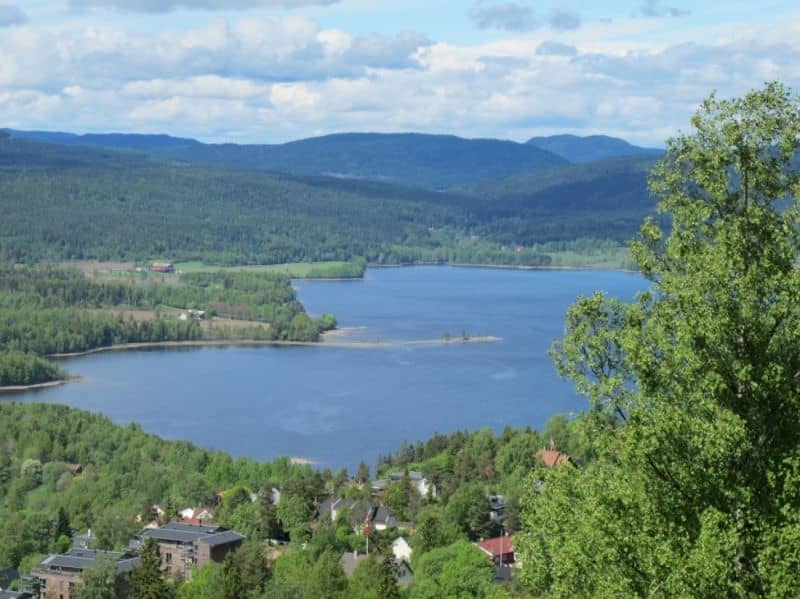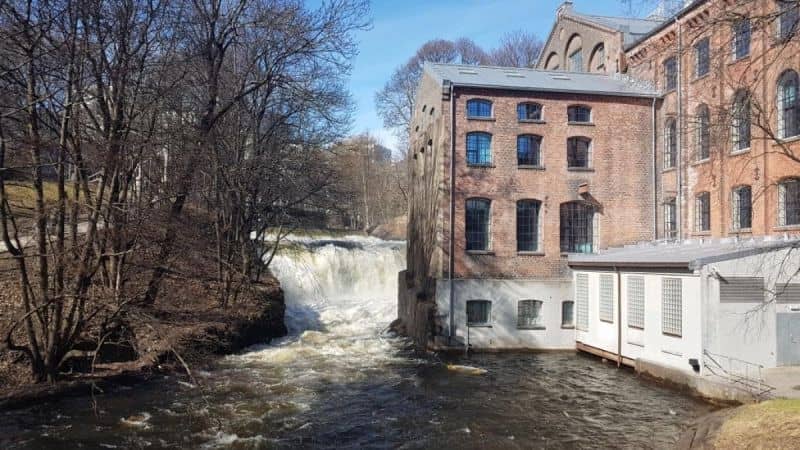BIKE TOUR ALONG THE AKERSELVA RIVER
This tour follows the whole length of Akerselva river, starting at lake Maridalsvannet at the edge of the Oslo forest, and ending in the city center by the Opera and the Oslo Fjord. The river is ca. 8 km long, and there is a continous park belt all the way, with a bicycle road that only crosses a couple of streets. The height difference from lake to fjord is 149 m, which means that we are going downhill or on level ground the whole time, so this is an easy and comfortable tour.
The river has 20 small waterfalls, and Frysja, the old name of the river, may have meant ”the frothing”, a reference to the waterfalls. We also see old industrial structures, which one can find along most of the river. These factories were the first modern industry in Norway, from the 1850s. Today, most have been renovated and given new funcions, often cultural. Akerselva river is an important part of Oslo’s identity, and has traditionally been the divide between the working class eastern parts of town, and the bourgeoisie in the west. Formerly heavily polluted, it is today clean enough to attract wild salmon and trout, and on a nice summer day, why not have a refreshing bath?
We will visit:
- Nydalen transformation project. Formerly an industrial area, dominated by the Spikerverket steelworks, Nydalen has been changed into a thriving urban area, mainly developed by the Avantor real estate company during the last 25 years. The area has ca. 4.000 inhabitants, with ca. 18.000 workplaces, and has a fast connection to the city center by metro. We take a look at projects by arch. Kristin Jarmund, arch. Niels Torp and MAD arch., as well as the riverside landscape architecture.
- We go further downstream to Bjølsen, past new housing projects, crossing the river on the new Jericho pedestrian bridge. Here we look at the Lilleborg factory project, with both renovated old structures and new blocks of flats. Then through Myraløkka park to the old wooden working class houses at Sagene, and nearby Vøienvollen, a well-preserved 18th century farm, today a museum.
- At Beierbrua we see the dramatic Hjulafossen waterfall, and Glademøllen, Norway’s oldest excisting industrial building from 1736. This area is an intact example of the typical 19th century east side cityscape, with original workers’ houses, factories, local school and public bath. From here, we make a short detour eastwards, to see the infill housing project Green House D36 by Element arch. Then through the central parts of Grünerløkka, a trendy, renovated working class district from the end of the 19th century. Here we also see the Oslo National Academy of the Arts, a mixture of renovated and new buildings.
- Back at the river, we cross the old Åmot suspension bridge, and roll down to the Vulkan project, the last major factory district to be opened to the public. Developed by the Vulkan Eiendom company, this area has become a popular venue for both locals and visitors, with a concentration of interesting buildings like the Mathallen food court (arch. LPO, who also made the Vulkan master plan), the Bellona environmental NGO office (arch. LPO), which when built was a pioneer project in energy efficiency, and Westerdals School of Communication (arch. Kristin Jarmund). Vulkan also features cultural venues, new housing and restaurants.
- Lunch in the Vulkan area. We will also have one of two coffee breaks during the tour.
- Nearby Vulkan is the Oslo School of Architecture and Design in an industrial structure from the 1930s (arch. Jarmund & Vigsnæs), the “Student Silo”; a grain silo from 1953 converted into student housing (arch. HRTB), and the idyllic old wooden suburb Telthusbakken.
- A few minutes from Vulkan is Brenneriveien street, a center for “alternative culture” with Oslo’s main jazzclub Blå, and cafes. Directly downstream is DogA, the center for design and architecture in Norway, in a former transformer building (arch. Jensen & Skodvin, rooftop housing arch. A38). Rough concrete and steel dominate the interior, where the architects have left traces of previous versions of the house, to show how the building has changed over time.
- We are now in the oldest part of the riverside park, from the early 20th century, where the main element is Ankerbrua, a stone bridge with sculptures representing Norwegian fairy tales. The intention was to have this kind of park belt all along the river, demolishing most of the old buildings. Today we are happy that this plan was not fulfilled. If time and office hours allow, we take a short look at the Oslo City Model, in the lobby of the town planning office. The last part of the tour takes us to the Grønland district, a trendy multicultural part of Oslo, and via Oslo Central Station to the waterfront project Bjørvika, where the river has been re-opened and integrated into the new urban fabric, between the Opera (arch. Snøhetta) and the new Munch Museum (arch. Estudio Herreros). Here, at the mouth of Akerselva, our journey ends by the Oslo Fjord.
| Duration: | Ca. 8 hours, incl. lunch and coffee break | |
| Transport: | Rental bike | |
| Services: | Experienced local architect as guide, meet and greet at pick up point, lunch reservation | |
| Languages: | Scandinavian, English, German | |
| Group size: | Max. 25 pax | |
| Price: | Please contact us for a quote | |
| Not included: | Consumption at restaurant / cafe, bike rental |














